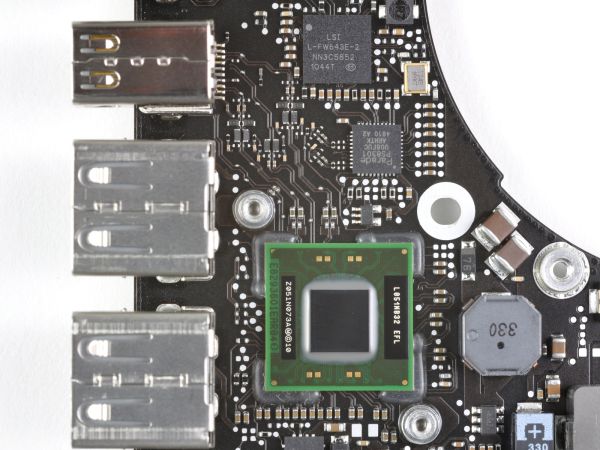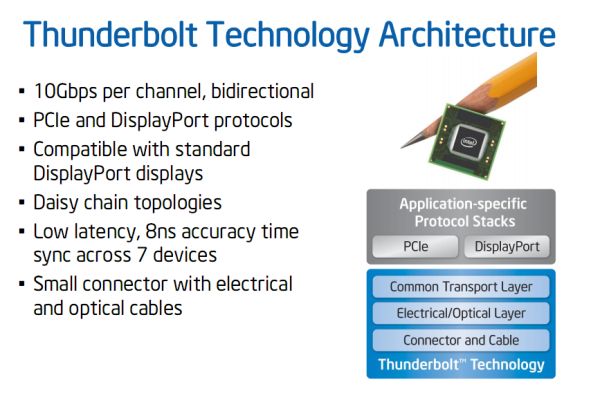Intel's Codename Light Peak Launches as Thunderbolt
by Brian Klug on February 25, 2011 1:10 AM EST- Posted in
- CPUs
- LightPeak
- News
- Thunderbolt
Back at IDF 2010, we wrote about Intel Light Peak nearing its eventual launch in 2011. Back then, the story was a 10 Gbps or faster physical link tunneling virtually every protocol under the sun over optical fiber. Though an optical physical layer provided the speed, in reality the connector and physical layer itself wasn’t as important as the tunneling and signaling going on beneath it. The dream was to provide a unified interface with enough bandwidth to satisfy virtually everything desktop users need at the same time - DVI, HDMI, DisplayPort, USB, FireWire, SATA, you name it. Daisy chain devices together, and connect everything with one unified connector and port. At IDF, we saw it moving data around between an Avid HD I/O box, a Western Digital external RAID array, and simultaneously outputting audio and video over HDMI. Intel also had another live demo working at over 6.5 Gbps.
That dream lives on today, but sans optical fiber and under a different name. Intel’s codename “Light Peak” is now named Thunderbolt. In addition, instead of optical fiber, ordinary copper does an adequate enough job until suitably cheap optical components are available. It’s a bit tough to swallow that optical fiber for the desktop still isn’t quite ready for mainstream consumption - issues like bend radius and the proper connectors were already mitigated - but copper is good enough in the meantime. Thunderbolt launched with the 2011 MacBook Pro, and though the interface isn’t Apple exclusive, will likely not see adoption in the PC space until 2012.
Although Thunderbolt in its launch instantiation is electrical, future versions will move to and support optical connections. When the transition to optical takes place, legacy electrical connector devices will work through cables with an electro-optical transceiver on the cable ends so there won’t be any need to use two separate kinds of cables. The optical version of Thunderbolt is allegedly coming later this year.
Thunderbolt shares the same connectors and cabling with mini DisplayPort, however Thunderbolt cables have different, tighter design requirements to fully support Thunderbolt signaling. DisplayPort is an interesting choice since it’s already one of the fastest (if not the fastest) desktop interfaces, topping out at 17.28 Gbps in DisplayPort 1.2 at lengths of under 3 meters. At longer distances, physics rears its ugly head, and throughput drops off over electrical links. Of course, the eventual advantages of moving to photons instead of electrons are greater distance without picking up much latency.
Thunderbolt is dual-channel, with each channel supporting 10 Gbps of bidirectional bandwidth. That’s a potential 20 Gbps of upstream and 20 Gbps of downstream bandwidth. The connection supports a daisy chain topology, and Thunderbolt also supports power over the cable, 10W to be precise. We aren't sure at this time what the breakdown on voltage/amperage is though.
Back when it was Light Peak, the goal was to tunnel every protocol under the sun over a common fast link. Multiplex everything together over one protocol-agnostic link, and then you could drop relevant data for each peripheral at each device in the daisy chain. Up to 2 high-resolution DisplayPort 1.1a displays and 7 total devices can be daisy chained. Thunderbolt instead carries just two protocols - DisplayPort and PCI Express. Tunnel a PCIe lane over the link, and you can dump it out on a peripheral and use a local SATA, FireWire, USB, or Gigabit ethernet controller to do the heavy lifting. Essentially any PCI Express controller can be combined with the Thunderbolt controller to act like an adapter. If you want video from the GPU, a separate dedicated DisplayPort link will work as well. Looking at the topology, a 4x PCI Express link is required in addition to a direct DisplayPort connection from the GPU.
Apple learned its lesson after FireWire licensing slowed adoption - the Thunderbolt port and controller specification are entirely Intel’s. Similarly, there’s no per-port licensing fee or royalty for peripheral manufacturers to use the port or the Thunderbolt controller. iFixit beat Anand and me to tearing down the 2011 MacBook Pro (though I did have one open, and was hastily cramming my OptiBay+SSD and HDD combo inside) and already got a shot of Intel's Thunderbolt controller, which itself is large enough to be unmistakable:
 Thunderbolt Controller IC on 15" 2011 MacBook Pro - Courtesy iFixit
Thunderbolt Controller IC on 15" 2011 MacBook Pro - Courtesy iFixit
In addition, you can still plug normal mini Display Port devices into Thunderbolt ports and just drive video if you so choose.
Though there aren’t any Thunderbolt compatible peripherals on the market right now, Western Digital, LaCie, and Promise have announced storage solutions with Thunderbolt support. Further, a number of media creation vendors have announced or already demonstrated support, like the Avid HD I/O box we saw at IDF.
Thunderbolt already faces competition from 4.8 Gbps USB 3.0 which has already seen a lot of adoption on the PC side. The parallels between USB 2.0 / FireWire and USB 3.0 / Thunderbolt are difficult to ignore, and ultimately peripheral availability and noticeable speed differences will sell one over the other in the long run. Moving forwards, it’ll be interesting to see Thunderbolt finally realize the “light” part of Light Peak’s codename, and exactly how that transition works out for the fledgling interface.















106 Comments
View All Comments
flyingpants1 - Friday, February 25, 2011 - link
"Tunnel a PCIe lane over the link, and you can dump it out on a peripheral and use a local SATA, FireWire, USB, or Gigabit ethernet controller to do the heavy lifting. Essentially any PCI Express controller can be combined with the Thunderbolt controller to act like an adapter."So can thunderbolt transport USB and SATA or not? Would it be possible to design an external hard drive with a Thunderbolt interface, and have it implement SATA? Or USB 3.0? Or how is this supposed to work exactly?
I want 12 Thunderbolt ports and no USB/eSATA/HDMI/DVI/Displayport.
puttersonsale - Friday, February 25, 2011 - link
that is a nifty idea....would be nice to have 1 cable type for all....i bet intel is thinking bout it. they want your $$$softdrinkviking - Friday, February 25, 2011 - link
you can transport USB 3 or whatever else you want over thunderbolt if you "tunnel a PCIe link" over the link.meaning you have to use a PCIe adapter to send the data as PCIe protocol, so thunderbolt can transport it.
then, on the other side, the signal gets dropped into another PCIe adapter and either converted into something else, like USB 3, or maybe SATA, or just sent as PCIe to wherever.
it was originally going to carry ALL of the various protocols that are around today, and then drop data off at whatever adapter was waiting for it with no middle-men, but intel changed that for some reason. i think it must be cost-related, but i'm jaded and distrustful.
Poulsen8r - Friday, February 25, 2011 - link
... at 2 metres. DP 1.2 is 17.28Gbps at the same distance. I love the idea but i think they need more bandwidth to support multi-monitor, high res/refresh setups since if you are sending data and video over the same wire it may become bottlenecked faster than you think. I also don't get why there is a 10Gbps interface when the fastest internal drives are capped at 6Gbps and therefore an eSATA drive on a SATA 3 controller will send data (obviously not video) at the same rate as a 'Thunderbolt' port.As many people are asking though, it will support any other interface you can put the controller on, so you can have Thunderbolt to USB adapters or eSATA or Graphics or RAID cards or Network or whatever you can plug into a normal PCIe slot.
Seems like today 4 more of my PCIe lanes are wasted on a not needed (at this time) technology. As for the future when it moves to fibre and we ditch the crappy SATA interface for internal storage, I think I'll be sold then.
It may be cool that I can plug any usb device into any version of the port and it will work, but backward compatibility slows down forward advancement. Everyone should realise this due to the sandy bridge woes that were caused by a transistor used for some type of legacy operation. New port = more win, sooner.
phatboye - Friday, February 25, 2011 - link
My biggest question is about the licensing of this proprietary link? Will Intel license this technology out to other integrated circuit makers like NEC, AMD, TI, NVIDIA etc? And at what cost will they license this out for? If Intel will be the only company producing Thunderbolt chips then I am not interested at all because you will not see widespread adoption of this interface like we see with USB.SunLord - Friday, February 25, 2011 - link
I have no doubt Intel will license out the controller but I doubt many will use it to integrate it into anything for now like usb 3.0 but worse. That chip is massive and is likely a 45 or 32nm part so even at 28nm it would be kinda large to put on die with a chipset or soc. It would be interesting to put it on a video card though since they could use it to output all the video signals and it kinda would make sense with PCIe 3.0 just around the corner you'd have alot of unused bandiwth on a 16x port to abusesoftdrinkviking - Friday, February 25, 2011 - link
it's supposed to be free, that's it's big deal selling point.intel's making the loot off of selling the controllers and the port hardware.
phatboye - Friday, February 25, 2011 - link
yes it's free to use the port but I am talking about licensing the protocol so that other IC manufactures can make controllers.iwod - Friday, February 25, 2011 - link
IT is actually very UNlikely a 45 or 32nm Chip. It would properly be at best 65nm or 90nm Controller.Anato - Friday, February 25, 2011 - link
Not supporting other protocols is a mistake. Instead of supporting motherboard's quality controller in drivers there is need to support myriad of controllers with different quality and drivers. We will definitely see Thunderbold -> USB3 -> SATA combination for HDD's and thats bad.